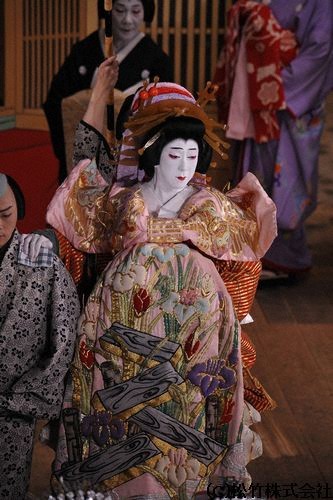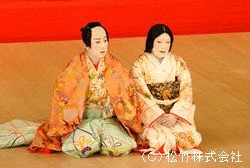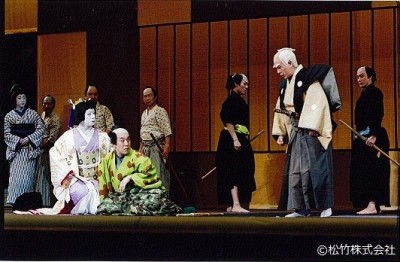Cinema Kabuki

- This event has passed.
February 28th, 2015 - March 1st, 2015
Cost: $22.75Details »

Cinema Kabuki
in high definition on the big screen
February 28 & March 1, 2015 at the TIFF Bell Lightbox, Toronto
Direct from Japan/Subtitled in English
Kabuki Theatre, with origins dating back to the 1600s, has remained steeped in tradition while constantly innovating. Live productions, featuring some of today’s greatest Kabuki stars, are now being filmed with the highest resolution cameras for screening in cinemas around the world on state-of-the-art digital projection systems and six-channel sound.
Calendar of screenings
TIFF Bell Lightbox, 350 King Street West, Toronto
Saturday, February 28, 2015
1:00 pm The Zen Substitute
3:00 pm The Revenge on Togitatsu
Sunday, March 1, 2015
1:00 pm Lion Dance, Kagamijishi
3:30 pm Kagotsurube, The Haunted Sword
Additional Events
Talk Series at The Japan Foundation, Toronto (Details TBA
Ticket sales open January 14 for TIFF members, January 22 for non-members
website
416.599.TIFF (8433) or in person at the Steve & Rashmi Gupta Box Office at TIFF Bell Lightbox
$22.75 (includes HST but not service fees) (TIFF member discounts apply)
For more information: 416.966.1600 ex.229


(c) Shochiku Pictures
The Zen Substitute
(a dance comedy)
Migawari Zazen
Premiere: 1910
Written by Shiko Okamura/Directed for Cinema Kabuki by Kiyoshi Sekine
Recorded live at Kabuki-za Theatre, Tokyo, 2009
62 minutes, subtitled in English
Lord Ukyo announces to his wife that he will hold a Zen-prayer session, locking himself in a pavilion overnight. But the truth is that he wants to sneak out to see a woman he encountered on his recent trip. A love affair is fun, and a little cheating would not cause too much harm. As a substitute, a poor servant is forced to stay in the prayer pavilion in place of the lord. Although the lord’s wife is not supposed to visit her husband out of respect for his isolation, she is so monstrously affectionate that she breaks her promise… A simple domestic farce is elevated to an expression of the joyful energy of life by two of the best dancers of the Kabuki world, Kanzaburo and Mitsugoro.
return to top

(c) Shochiku Pictures
The Revenge on Togitatsu
(a satiric comedy)
Togitatsu no Utare
Premiere: 2001
Written and directed for stage by Hideki Noda/directed for Cinema Kabuki by Hiroyuki Nakatani
Recorded live at Kabuki-za Theatre, Tokyo, 2005
Kanzaburo, Fukusuke, Somegoro, Kantaro, Mitsugoro
97 minutes, subtitled in English
Contemporary playwright/director Hideki Noda updated this Kabuki play by loading it with irony and criticism of today’s society. Tatsuji is a sword-sharpener from the commoner class who was recently accepted to samurai rank. His “successful” rise in the hierarchy was merely the result of his clever verbal tactics and materialistic values. He blames his own failures on others, shows no respect for the noble philosophy of the samurai, and impertinently flatters the lady of the house. Somehow, he happens to become caught in a situation in which he is hunted by two brothers avenging their father’s death. The gigantic revolving stage represents the hilarious chase across Japan. In the play, the common people display their hunger for an honourable hero who will amuse them. The avengers are as reluctant as Tatsuji, who is entirely exhausted by continually escaping from them. Isn’t the revenge simply a murder? What is all this killing for? Visual quotations from global culture, such as baseball and West Side Story, sparklingly decorate the piece on the surface, yet dark questions still lie just underneath.
return to top

(c) Shochiku Pictures
Lion Dance
(a dance performance)
Kagamijishi
Premiered in 1893
Written by Ochi Fukuchi/Composed by Shojiro Kineya III/Directed for Cinema Kabuki by Sokichi Sagawa
Recorded live at Kabuki-za Theatre, Tokyo, 2009
70 min. (Introduction 10 min. + 59 min ), subtitled in English
For the late Kanzaburo XVIII “Lion Dance” was the most precious gem of his family tradition. Danjuro IX, who created the piece, was the mentor of Kanzaburo’s grandfather, Kikugoro VI. Four generations of the best Kabuki actors of their eras nurtured “Kagami Jishi” and developed it into one of the best examples of the dance repertoire in Kabuki theatre. A single dancer conjures up a stunning contrast of two images: A young maiden in the Shogun’s castle is transformed by the spirit of the majestic Shishi, a mythical animal. The healthy, sophisticated eroticism of a young woman is described by the dancer in the first part. She is noble, sensitive, yet coquettish at times. But, when the spirit of the ferocious Shishi takes over her body, the animal stamps the earth, and swings his mane in the air, celebrating the prosperity and glory of life.
Preceded by:
Kikugoro VI Dances Kagamijishi
(Documentary)
Kikugoro no Kagamijishi
1936
Directed by Yasujiro Ozu (1903-1963)
Special screening of the archival footage in association with the Cinema Kabuki “Lion Dance”
The Japan Cultural Association commissioned this theatrical documentary to introduce Japanese culture abroad. The scenes were shot in 1935 and 1936. Two masters crowned this precious cultural legacy: Kabuki actor Kikugoro VI and filmmaker Yasujiro Ozu. The genius of the dancing talent of Kikugoro was captured by Ozu, so free in form and full of spontaneity. Kagamijishi is Mt. Everest for Kabuki actors to challenge, and all contemporary performers study this film so closely when they are assigned to dance this piece. So did Kanzaburo XVIII, the only grandson of Kikugoro VI.
return to top

(c) Shochiku Pictures
Kagotsurube, The Haunted Sword
(a story of the pleasure quarter)
Kagotsurube Sato no Eizame
Premiere: 1888
Written by Shinshichi Kawatake/Directed for Cinema Kabuki by Hiroyuki Nakatani
Recorded live at Kabuki-za Theatre, Tokyo, 2010
113 minutes, subtitled in English
On the main street of the Yoshiwara pleasure district the top courtesan Yatsuhashi makes a luxurious procession through the fully blooming cherry trees. Miraculously, she happens to smile at Jirozaemon, a country merchant in the crowd. Who would have ever imagined that this momentary encounter could be the cause of a mass murder? A love triangle forces the courtesan to reject her best customer in the middle of a banquet — the most dishonourable humiliation of all. Jirozaemon seizes the haunted sword Kagotsurube, which inevitably invites bloodshed once it is drawn. Kanzaburo and Tamasaburo are joined by Nizaemon to form a dream cast for this Kabuki classic.
return to top
